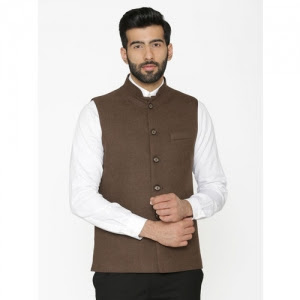Rajasthan's Traditional Printing Technique "BAGRU"-Printed Kurta for Men.
Rajasthan's Traditional Printing Technique "BAGRU"-Printed Kurta for Men.
Rajasthan's one of the well-known traditional techniques of printing- "BAGRU" printing founded by the chippas community of an isolated place of Rajasthan. Chippas are involved in these traditions over 100 years ago and the Raider or Chippa community are involved in manufacturing of leathers and processing of their goods. Their products involved Mochdi, boot, Rajasthani jhutee and other leather goods. Dabu printing is famous in Bagru as they are mixed with clay,wheat,gum,cow pies and limestone and printed on the fabric.
Synthetic dyes are now introduced to use in various colour combinations but nowadays village communities still have the practice to use the natural colour. People are used to obtain natural color from the pomegranate, harda, and Indigo.
THE HISTORY OF "BAGRU" PRINT:
From the beginning this kind of art is said to have started around 450 years ago. The village Chippa or traditional community used these fabrics by hand. These traditional people came from Alwar, Madhopur, Jhunjhuna and from some other districts of Rajasthan to permanently settle at Bagru. These people are well-known for their distinctively unique design of luxuriated trellises in different natural colors.
The base color of Bagru print is off-white and these colors are prepared from natural dyes.
The main natural color are prepared in these following ways by the traditional community printers:
1. NATURAL RED:
At the very first, a gum paste solution is paste in water and then strain through a cotton cloth. When the colour is applied on the fabric it appears brown in colour with the help of the blocks but after the fabric is placed in the furnace the color turns into red.
2. NATURAL BLACK:
For the natural black color camel-shoes or horse shoes are soaked in water and to which gud or molasses is added. This mixture is kept at least for 15 days. After, 15 days the water is drained off and used as a black pigment
There are other pigments or natural colors which are also used for printing such as:
1.Pink
2.Brown
3.Violet
4.Green
5.Rust
6.Blue
THE PROCESS OF BAGRU PRINTING:
The process of preparing Bagru print is quite easy and it looks like the practice and working of printing with natural dyes or elements which contains a critical series of steps as follows:
a. Preparation of raw cloth.
b.Making of dyes or natural colors
c.Steps that involves different types of printing designs
d.Developing complicated dyeing techniques for resist printing in particular.
This process begins with the plain cloth. The raw fabric usually contains different kinds of impurities like oil and dust, starch which needs to be cleaned to remove these impurities. The Chippa community requires two days to prepare a paste by mixing soda ash, sesame oil and cow-dung and washes the cloth with this mixture. This cloth is now washed, dried and ready for the "Harda" treatment. In these treatments the fabrics are then squeezed to dry and laid down in the sun. Almost each and every stage requires the cloth to be washed in water and dried in the sun to remove the impurities. Nowadays the village community made a new initiative to reuse the used water for recycling or charging inside the ground.
There are mainly two types of printing used in Bagru,- Direct Dye Printing and Resisting Printing. In both of the procedures, firstly the blocks are soaked with refined oil or mustard oil overnight and then washed. Wooden tables are mainly used for this printing, the size of the cloth of which depends on the length of to be printed.
Let us begin from the first process of "BAGRU" printing:
DIRECT DYE PRINTING:
In the very first process,the dye solutions need to be poured in the tray. The printer presses the block into the dye tray.The outline pattern is done in blocks for the background and highlights in different colors. Once each of the patterns is complete, the cloth is ready for the dye vat. This printing is mainly done by male printers.
RESIST PRINTING:
A different type of printing Technique of resist style called "DABU" printing, which is primarily known as for its mastery design.Its quintessence remain in printing with specially prepared "Dabu" paste, then they apply the thick black mud paste on the cloth and then dyeing the fabric. Each family follows its own trick to create a distinctive Dabu paste.
NEW ERA STYLING WITH "BAGRU" PRINT:
However, with the development of our lifestyle, culture, habits etc. The village chippas has also modified the Bagru print designs with different kinds of material. Nowadays Bagru print is not only used in sarees or for women clothing but also for mens wear and bed sheets. We can easily find Bagru print in any type of clothing. Basically, cotton fabric is being used for Bagru print. With the cotton fabric as it is very comfortable, smooth,and it also looks cosy and pleasant to wear during summers.
1. 100% Jaipur Cotton Blue short Indian Kurta
If you are all about comfort this summer, then cotton Bagru printed are for you. You can pair it with kurta pajamas or jeans and rock the look in any formal or informal event.
2. Jaipur 100% Cotton Blue Shirt
You need this one piece in your wardrobe for the quirky look .This one is perfect for the any purpose. Pair it with jeans, and you are ready to turn heads in any event.
3. Jaipur 100% Cotton Multicolored Long Kurta
A Multicolored Bagru Printed Kurta is not for the basic and faint-hearted. If bold and confident is your thing, then such Kurta will be brilliant assets for you and with its elegant look.
4. Jaipur 100% Cotton Black Kurta
This colored black kurta is to best to wear during summers. Pair it with jean or kurta pajamas. And Yes you are ready to go.

Comments
Post a Comment